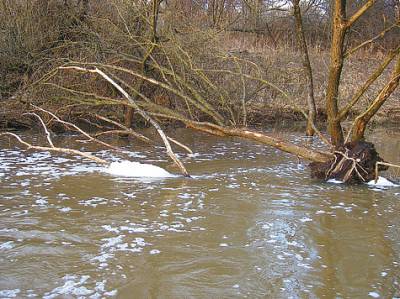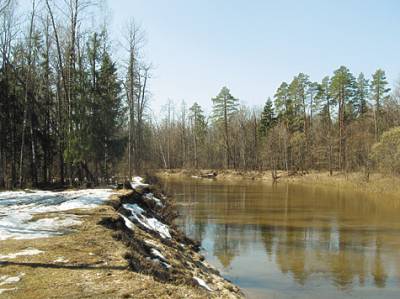
It often happens that our Northern spring is advancing slowly, without rapid warming and abrupt cold snap. Gradually the river free of ice, but the water flow under ice cover. At this time there comes a short period of fishing tackle float in pure water revealed the rivers, until they began the muddy flood.
Fishing in early spring on the course only seems simple because it seems and the flow is still not strong, and the water is not murky, and it is not floating debris, as in a flood. In fact, the main difficulty lies in fishing low fishing activity and very limited means of this activity is to promote and encourage the biting. Rather passive behaviour of fish, primarily due to a significant decrease in water temperature in the river when it begins to constantly do melt the “snow”, ice water.
One of the negative factors that would affect the fishing that is excessive illumination in which in the clear water turns the fish right after the ice melts, so she needs a lot of time for adaptation to new habitat conditions. Usually full addictive to light the fish comes after the end of the tide when the water is purified gradually from turbidity and illumination also increases slowly. Therefore, the best fishing will be cloudy, overcast days with a slight breeze.
Also ice water in the river and winter fishing, defines the strong selectivity of fish in the diet. Therefore, during the early spring fishing the fish are unlikely to be able to seduce something unusual for her: extremely low temperature environment slows down the biological processes in the organism of the fish, she goes on a diet exclusively animal food, mostly that which prevails in a particular river.
So it happens that in one river the fish bite better, say, on a caddis and the other on a dragonfly larva or a small variety of this larva, the so-called “Nairi”, somewhere nice catch on the crustacean amphipod or small and gentle leech-clasina. Of course, everywhere are biting on bloodworms, but at times or in certain places on this bait overly active attacks a trifle, making it difficult to catch something worthy. So, the angler in early spring, must be reserved for the possibility of different baits, but also desirable to be able to produce effective nozzle directly into the shery. For example, if to take with them to the river for a rake with a long handle or zatsepistye cat on a long rope and quickly pull them from the bottom of a few sunken branches, then they will probably be able to collect a few of caddisflies in “houses”. And various larvae of dragonflies, leeches, and amphipods find refuge in dense aquatic vegetation last year, a bunch of which you need to get to the shore and carefully disassemble, folding animals was found in a box with some wet filler or just a wet rag.
With regard to the complexity of the revitalization of biting fish when fishing in freezing water, here mainly refers to the complementary feeding. In this case, if you act according to the usual scheme, that is to take any standard formula based on vegetable components, even supposedly made for cold water, and mix it with the feed bloodworms, it being abandoned at the fishing place in early spring in the vast majority of cases gives a negative effect. However, there are rare positive moments, but they usually refer to the arrival of unnecessary stuff or annoying bleak.
However, in this case, there may be some options. For example, the same moth with the addition of a small amount of small maggots can be mixed with moist, but extremely friable soil, taken immediately on the shore. Sometimes one just earth, thrown in from time to time lumps in the fishing area, fish can cause interest, maybe leaving adrift the clouds of turbidity or a specific smell. Also, if you have distance catching, it is possible for distance casting tackle sometimes stir up the bottom soil with a long pole, creating a plume of turbidity and release of organic deposits from all small animals.
But the best is still to examine carefully the nature of specific prospective areas of the river, then with sufficient accuracy to find local places of natural accumulation of fish. It is clear that such areas are not where the river is straight and monotonous, like a pipe, or at great length a wide and shallow and where it is intricate meanders, where deep pools alternate with riffles, debris from trees, coastal podmaine, ditches and other characteristics. And in these conditions it is important to determine which places will gravitate to, for example, roach, Dace, Chub or IDE.
But for any choice of the object of fishing and the corresponding conditions and fishing snap the main technical device is the wiring, which corresponds to the natural movement of the feed together with the water flow. It is desirable that the bait on the hook was moving close to the bottom because cold water fish are rarely POPs up for food, going too high.
And yet, if the bottom is on all site wiring is clean and fairly smooth, it is better to catch the wire with the nozzle on the bottom. This bit depends on the nature of the bite: when a part of the leash and bait with a hook does not touch the bottom, float right orogeny when you grasp the fish rather abruptly disappearing under the water, and during delays at the bottom of the float suddenly slows down his move and starts to get flooded, almost as at a hook over a bottom obstacle. By the way, for catching in the wire of the float requires a little nadograditi not to observe a large number of false bites when the bait on the hook will “plow” the bottom, feeling somewhat variable in strength, counter-movement.
For free sailing, the float should ohrozit sensitive, almost to the very basis of the signal entence. But in both methods, the fish feed nozzle is never wasted and even useful implementation of a constant braking or a succession of short frederiek movement of the snap-in, which will lead to some game of the leash with the bait on the hook up and down. This technique often leads to a more distinct bite and secure landing of the fish. It is particularly convenient to perform primerica, when it is possible to get a Bank so that the wind was strictly against the current, then, lifting the fishing line between float and rod tip is above or dropping below, it is possible in a wide range to change the braking force, and eventually “please” the fish.
By the way, and about the device of snap-ins for spring fishing on the current: they must be well balanced under the conditions of catching, but very simple — a stable float with two or three attachment points to the line, with a long keel and a large widening of the body at the bottom. On the line only two elements of shipping — the main sinker (80% weight) and shepherd boy around the leash, which is a bit more thin the basic scaffold. Hook needed a thin, but quality — it is bait for a long time retains its original condition, at the same time, he often flexes at the toe and pinpoint well and keeps the fish even when the forced towing.
Also often the conditions are, when to catch in the transaction is almost impossible — a complex bottom, short section, a hurricane. Then the tackle is established in the form of prudence — ogruzka fully laid on the bottom, and the tightness of the fishing line is adjustable so that the water submerged the float retains maximum sensitivity. In the same way at times forced to have to catch already reviving in the spring, but slowly pecking fish such as crucian carp, tench, bream, which do not chase whatever is moving, and take food lying on the bottom. In addition, poledance very useful when fishing for large fish, when, getting rid of bites of little things, surround the bait used, for example, the Nightcrawlers, thick larva of the may beetle or the bark beetle, clam meat and cancer — this bait the fish are hard to take on the go.
In addition, there are fish that early in the spring and in the icy water quicker than others to adapt to difficult environmental conditions, and even fed regularly. These include roach, Dace, IDE and Chub. But only feed and are caught they are in significantly different places: roach and IDE find themselves in relatively deep and quiet areas near the shore, in sevodina and the swirls, where they are possible to catch in the wiring and on poludenko.
However, the largest Chub and Dace, on the contrary, sometimes find themselves in the powerful jet where the bottom is usually clean. Here they were very effective to catch the so-called method “on pokatok”, using as bait of Nightcrawlers on a bigger hook. The main thing — correctly to pick up under the force of the flow weight of spherical sinkers so that the stream from time to time tore-wheeled it along the bottom. The leash length is the meter is tied directly to the eyelet sinkers. The bite mark on the flexible tip of the rod, or by hanging the alarm device of any type. The grip of big Chub and in the spring the water is so sharp that to ignore it is impossible.
But you can extend this method by making it more active, “sports”, if, again using the power of the current, to move the snap-in force, short patikami by using a rod with a reel. In this case, the bait will move to the shore in an arc. Picking up the range and direction of the cast, as well as manipulating the weight of sinkers, it is possible without moving from a comfortable place, effectively to sh in different areas of the river bed.








